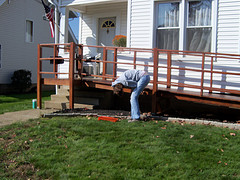How Much Does a Permanent Wheelchair Ramp Cost?
Wheelchair ramps make it possible for a disabled individual to go into elevated entranceways. Whether you’re attempting to enter a car, home, or office, a ramp allows you to do so independently. According to The Americans with Disabilities Act (ADA) of 1990, all newly-constructed businesses and public facilities must have wheelchair access. Though residential buildings and homes do not need to meet the same standards, if you are planning to build a wheelchair ramp, it’s recommended you follow the ADA guidelines.
A permanent wheelchair ramp enables a sturdy, independent means of access to your home. These are generally made of wood, steel, or concrete. While concrete is the most durable, it is also the most expensive and the most difficult to install. Steel ramps are more durable than wooden ramps, though they tend to be heavier, more expensive, and heat up in the sun. Wooden ramps are the most aesthetically pleasing, but need to be weatherproofed and treated in order to last.
Depending on the type of wood and other specifications, a permanent wheelchair ramp used to reach a height of 30 inches (30 feet long) can cost between $3,500 and $8,000, or between $100 and $250 per linear foot.
Even though you may only need 10 feet of ramp, you also need to install a horizontal platform at the beginning and end of the ramp, which the ADA recommends should be 60 inches long. Additionally, the ADA requirements call for the ramp to have a width of at least 36 inches, edge protection to keep from slipping off, and handrails. When choosing from professional carpenters near you make sure they are aware of the ADA guidelines and have experience building handicap-accessible structures.
Additional Costs
Be sure your carpenter takes weather conditions into account, especially if you live in a rainy climate like Milwaukee. Wood must be protected with sealer or varnish to prevent rotting and warping caused by rain and other moisture. If the handrails are wooden they must be finished and properly maintained to prevent splinters. The ramp boards should be placed close enough together to prevent uncomfortable gaps, while at the same time spaced far enough apart to allow for water drainage.
Unless the entrance to your home is directly under a streetlight, you may want to hire an electrician to install lighting either above or along the side your wheelchair ramp.
Portable Ramps
Portable wheelchair ramps are inexpensive and provide easy, on-the-spot assistance. However, they are typically used for getting into automobiles and other slightly-elevated entranceways, but cannot provide access to higher entrances. For example, a portable 5-foot ramp that follows the ADA guidelines will only reach about half a foot off the ground. Any entrance more than two-steps-high would be beyond its reach. Additionally, if the ramp is portable, a wheelchair-bound individual will likely not be able to set it up or transport it on their own, leaving them dependent on someone else.
All people deserve an easy, affordable means of going in and out of their home, without sacrificing aesthetic appeal. Contact a professional carpenter to discuss your home’s needs and ways a wheelchair ramp can best accommodate you. Be aware that some states provide funding for modifying homes of disabled individuals. Contact your local government representative to find out your rights.
Looking for a Pro? Call us (866) 441-6648

Carpentry Average Costs
Carpenters Experiences

Can’t Find A Prefab Shed You Like? Try Custom Carpentry Instead

A Great Contractor Will Guide You In Remodel Decisions That Work




